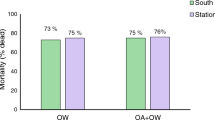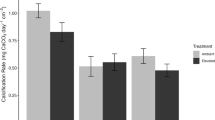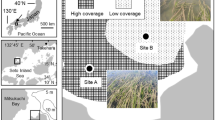Abstract
We performed a 30-month field study in a highly turbid, hypertrophic shallow lake from the Pampa Plain (Argentina) in order to investigate the occurrence of steady-state phases of phytoplankton, with an emphasis on the effect of subtle, but measurable, increase in light availability. The results revealed that a steady-state condition prevailed during the first 14 months, during which Aphanocapsa cf. delicatissima represented, on average, 91% of the total phytoplankton biomass. The statistical analyses provide support for the hypothesis that low light availability in the water column regulates the structure of the algal assemblage in this lake. Our results agree with predictions of the light-limited growth theory (i.e. the observed increase in light supply promoted an increase in algal density) and are also consistent with the notion that environmental constraints influence the dominant morphological traits in phytoplankton assemblages, particularly, that small organisms and/or attenuated forms are favoured under very poor light conditions. Nevertheless, further work is needed to get a full understanding of the processes controlling phytoplankton dynamics in this lake, including careful studies of the ecophysiology of the colonies comprising pico-sized cells of Aphanocapsa cf. delicatissima that dominated the assemblage during all the studied period.







Similar content being viewed by others
References
Allende, L. & I. Izaguirre, 2003. The role of physical stability on the establishment of steady states in the phytoplankton community of two Maritime Antarctic lakes. Hydrobiologia 502: 211–224.
Allende, L., G. Tell, H. Zagarese, A. Torremorell, G. Pérez, J. Bustingorry, R. Escaray & I. Izaguirre, 2009. Phytoplankton and primary production in clear-vegetated, inorganic-turbid, and algal-turbid shallow lakes from the pampa plain (Argentina). Hydrobiologia 624: 45–60.
APHA (American Public Health Association), 1992. Standard methods for the examination of water and wastewaters. 20th Ed Water Environment Federation, Arlington, VA.
Becker, V., V. L. M. Huszar, L. Naselli-Flores & J. Padisák, 2008. Phytoplankton equilibrium phases during thermal stratification in a deep subtropical reservoir. Freshwater Biology 53: 952–963.
Callieri, C., A. Lami & R. Bertoni, 2011. Microcolony formation by single-cell Synechococcus strains as a fast response to UV radiation. Applied and Environmental Microbiology 77: 7533–7540.
Callieri, C., G. Cronberg & J. G. Stockner, 2012. Freshwater picocyanobacteria: single cells, microcolonies and colonial forms. In Whitton, B. A. (ed.), Ecology of Cyanobacteria II: Their Diversity in Space and Time. Springer Science+Business Media B.V, Dordrecht.
Caraco, N. F. & R. Miller, 1998. Effects of CO2 on competition between a cyanobacterium and eukaryotic phytoplankton. Canadian Journal of Fisheries and Aquatic Science 55: 54–62.
Clarke, K. & M. Ainsworth, 1993. A method of linking multivariate community structure to environmental variables. Marine Ecology Progress Series 92: 205.
Conzonno, V. H. & E. F. Claverie, 1990. Chemical characteristics of the water of Chascomús pond (Provincia de Buenos Aires, Argentina): limnological implications. Revista Brasileira de Biologia 50: 15–21.
Conzzono, V. & A. Fernandez Cirelli, 1988. Soluble humic substances from Lake Chascomús (Argentina). Archiv fûr Hydrobiologie 109: 305–314.
Conzzono, V. & A. Fernandez Cirelli, 1996. Humic substances and phytoplankton primary production in Chascomús pond (Argentina). Facts and speculations. Revista de la Asociación de Ciencias Naturales del Litoral 27: 35–42.
Diehl, S., 2002. Phytoplankton, light and nutrients in a gradient of mixing depths: theory. Ecology 83: 386–398.
Diehl, S., 2007. Paradoxes of enrichment: effects of increased light versus nutrient supply on pelagic producer–grazer systems. The American Naturalist 169: 174–191.
Diovisalvi, N., G. Berasain, F. Unrein, D. Colautti, M. E. Llames, A. Torremorell, P. Fermani, L. Lagomarsino, G. Perez, R. Escaray, J. Bustingorry, M. Ferraro & H. Zagarese, 2010. Chascomús: estructura y funcionamiento de una laguna pampeana turbia. Ecología Austral 20: 115–127.
Dokulil, M., 1988. Seasonal and spatial distribution of cryptophycean species in the deep, stratifying, alpine lake Mondsee and their role in the food web. Hydrobiologia 161: 185–201.
Elber, F. & F. Schanz, 1989. The causes of change in the diversity and stability of phytoplankton communities in small lakes. Freshwater Biology 21: 237–251.
Flöder, S., J. Urabe & Z. I. Kawabata, 2002. The influence of fluctuating light intensities on species composition and diversity of natural phytoplankton communities. Oecologia 133: 395–401.
García de Emiliani, M., 1993. Seasonal succession of phytoplankton in a lake of the Paraná River floodplain, Argentina. Hydrobiologia 264: 101–114.
Hammer, Ø., D. A. T. Harper & P. D. Ryan, 2001. PAST: paleontological statistics software for education and data analysis. Palaeontologia Electronica 4: 1–9.
Hardin, G., 1960. The competitive exclusion principle. Science 131: 1292–1297.
Harris, G. P., 1986. Phytoplankton Ecology. Chapman & Hall, London.
Havens, K. E., E. J. Phlips, M. F. Cichra & B. L. Li, 1998. Light availability as a possible regulator of cyanobacteria species composition in a shallow subtropical lake. Freshwater Biology 39: 547–556.
Hillebrand, H., C. D. Dürselen, D. Kirschtel, U. Pollingher & T. Zohary, 1999. Biovolume calculation for pelagic and benthic microalgae. Journal of Phycology 35: 403–424.
Hooper, D. U. & P. M. Vitousek, 1997. The effects of plant composition and diversity on ecosystem processes. Science 277: 1302–1305.
Huisman, J., 1999. Population dynamics of light-limited phytoplankton: microcosm experiments. Ecology 80: 202–210.
Huisman, J. & F. J. Weissing, 1994. Light-limited growth and competition for light in well-mixed aquatic environments: an elementary model. Ecology 75: 507–520.
Huisman, J. & F. J. Weissing, 1995. Competition for nutrients and light among phytoplankton species in a mixed water column: theoretical studies. Water Science and Technology 32: 143–147.
Huisman, J., R. R. Jokner, C. Zonneveld & F. Weissing, 1999. Competition for light between phytoplankton species: experimental tests of mechanistic theory. Ecology 80: 211–222.
Huston, M. A., 1997. Hidden treatments in ecological experiments: re-evaluating the ecosystem function of biodiversity. Oecologia 110: 449–460.
Iriondo, M. H. & E. C. Drago, 2004. The headwater hydrographic characteristics of large plains: the Pampa case. Ecohydrology and Hydrobiology 4: 7–16.
Izaguirre, I. & A. Vinocur, 1994. Typology of shallow lakes of the Salado River basin (Argentina), based on phytoplankton communities. Hydrobiologia 277(1): 49–62.
Kirk, J. T. O., 1994. Light and Photosynthesis in Aquatic Ecosystems. Cambridge University Press, Cambridge.
Lagomarsino, L., G. Pérez, R. Escaray, J. Bustingorry & H. Zagarese, 2011. Weather variables as drivers of seasonal phosphorus dynamics in a shallow hypertrophic lake (Laguna Chascomús, Argentina). Fundamental and Applied Limnology 178: 191–201.
Litchman, E., 2003. Competition and coexistence of phytoplankton under fluctuating light: experiments with two cyanobacteria. Aquatic Microbial Ecology 31: 241–248.
Litchman, E. & C. A. Klausmeier, 2001. Competition of phytoplankton under fluctuating light. The American Naturalist 157: 170–187.
Llames, M. E., L. Lagomarsino, N. Diovisalvi, P. Fermani, A. Torremorell, G. Pérez, F. Unrein, J. F. Bustingorry, R. Escaray, M. Ferraro & H. Zagarese, 2009. The effects of different degrees of light availability in shallow, eutrophic waters: a mesocosm study. Journal of Plankton Research 31: 1517–1529.
Margalef, R., 1983. Limnología. Ediciones Omega, Barcelona.
Marker, A. F. H., C. A. Crowther & R. J. M. Gunn, 1980. Methanol and acetone as solvents for estimating chlorophyll a and pheopigments by spectrophotometry. Ergebnisse Der Limnologie 14: 52–69.
Morabito, G., A. Oggioni & P. Panzani, 2003. Phytoplankton assemblage at equilibrium in large and deep subalpine lakes: a case study from Lago Maggiore (N. Italy). Hydrobiologia 502: 37–48.
Naselli-Flores, L., J. Padisák, M. T. Dokulil & I. Chorus, 2003. Equilibrium/steady-state concept in phytoplankton ecology. Hydrobiologia 502: 395–403.
Nicklisch, A., T. Shatwell & J. Köhler, 2008. Analysis and modelling of the interactive effects of temperature and light on phytoplankton growth and relevance for the spring bloom. Journal of Plankton Research 30: 75–91.
O’Farrell, I., P. de Tezanos Pinto & I. Izaguirre, 2007. Phytoplankton morphological response to the underwater light conditions in a vegetated wetland. Hydrobiologia 578: 65–77.
Ortega-Mayagoitia, E., C. Rojo & M. A. Rodrigo, 2003. Controlling factors of phytoplankton assemblages in wetlands: an experimental approach. Hydrobiologia 502: 177–186.
Padisák, J., 1993. The influence of different disturbance frequencies on the species richness, diversity and equitability of phytoplankton in shallow lakes. Hydrobiologia 249(1-3): 135–156.
Padisák, J., G. Borics, G. Fehér, I. Grigorszky, I. Oldal, A. Schmidt & Z. Zámbóné-Doma, 2003. Dominant species, functional assemblages and frequency of equilibrium phases in late summer phytoplankton assemblages in Hungarian small shallow lakes. Hydrobiologia 502: 157–168.
Padisák, J., L. O. Crossetti & L. Naselli-Flores, 2009. Use and misuse in the application of the phytoplankton functional classification: a critical review with updates. Hydrobiologia 621: 1–19.
Passarge, J., S. Hol, M. Escher & J. Huisman, 2006. Competition for nutrients and light: stable coexistence, alternative stable states, or competitive exclusion? Ecological Monographs 76: 57–72.
Pérez, G. L., M. E. Llames, L. Lagomarsino & H. Zagarese, 2011. Seasonal variability of optical properties in a highly turbid lake (Laguna Chascomús, Argentina). Photochemistry and photobiology 87(3): 659–670.
Petersen, R., 1975. The paradox of the plankton: an equilibrium hypothesis. The American Naturalist 109: 35–49.
Pielou, E. C., 1977. Mathematical Ecology. Wiley, New York.
Quirós, R. & E. Drago, 1999. The environmental state of Argentinean lakes: an overview. Lakes Reservoirs: Reservoirs Management 4: 55–64.
Quirós, R., J. J. Rosso, A. Rennella, A. Sosnovsky & M. B. Boveri, 2002. Análisis del estado trófico de las lagunas pampeanas (Argentina). Interciencia 11: 584–591.
Quirós, R., M. B. Boveri, C. A. Petrachi, A. Ranella, J. J. Rosso, A. Sosnovky & H. T. van Bernard, 2006. Los efectos de la agriculturización del humedal pampeano sobre la eutrofización de sus lagunas. En: Tundizi, J. G., T. Matsumura-Tundisi y C. Sidagis Galli (eds), Eutrofizaçao na América do Sul: Causes, conseqüèncias e tecnologías de gerenciamento e controle: 1–16.
Reynolds, C. S., 1997. Vegetation Processes in the Pelagic: A Model for Ecosystems Theory. Ecology Institute, Oldendorf.
Reynolds, C. S., V. Huszar, C. Kurk, L. Naselli-Flores & S. Melo, 2002. Towards a functional classification of the freshwater phytoplankton. Journal of Plankton Research 24: 417–428.
Rojo, C. & M. Alvarez-Cobelas, 2003. Are there steady-state phytoplankton assemblages in the field? Hydrobiologia 502: 3–12.
Sakshaug, E., A. Bricaud, Y. Dandonneau, P. G. Falkowski, D. A. Kiefer, L. Legendre, A. Morel, J. Parslow & M. Takahashi, 1997. Parameters of photosynthesis: definitions, theory and interpretation of results. Journal of Plankton Research 19: 1637–1670.
Salmaso, N., 2003. Life strategies, dominance patterns and mechanisms promoting species coexistence in phytoplankton communities along complex environmental gradients. Hydrobiologia 502: 13–36.
Scheffer, M., 1998. Ecology of Shallow Lakes. Chapman & Hall, London.
Scheffer, M., S. H. Hosper, M. L. Meijer, B. Moss & E. Jeppesen, 1993. Alternative equilibria in shallow lakes. Trends in Ecology and Evolution 8: 275–279.
Schwaderer, A. S., K. Yoshiyama, P. de Tezanos Pinto, N. G. Swenson, C. Klausmeier & E. Litchman, 2011. Eco-evolutionary differences in light utilization traits and distributions of freshwater phytoplankton. Limnology and Oceanography 56: 589–598.
Seip, K. & C. Reynolds, 1995. Phytoplankton functional attributes along trophic gradient and season. Limnology and Oceanography 40: 589–597.
Shapiro, J., 1990. Current beliefs regarding dominance by blue-greens: the case for the importance of CO2 and pH. Verhandlungen der Internationalen Vereinigung für Theoretische und Angewandte Limnologie 24: 38–54.
Soares, M. C. S., L. O. Vidal, F. Roland & V. L. M. Huszar, 2009. Cyanobacterial equilibrium phases in a small tropical impoundment. Journal of Plankton Research 31: 1331–1338.
Sommer, U., 1985. Comparison between steady state and nonsteady state competition: experiments with natural phytoplankton. Limnology and Oceanography 30: 335–346.
Sommer, U., J. Padisák, C. S. Reynolds & P. Juhász-Nagy, 1993. Hutchinson’s heritage: the diversity–disturbance relationship in phytoplankton. Hydrobiologia 249: 1–7.
ter Braak, C. J. F., 1986. Canonical correspondence analysis: a new eigenvector technique for multivariate direct gradient analysis. Ecology 67: 1167–1179.
ter Braak, C. J. F. & P. Smilauer, 1998. CANOCO Reference Manual and User’s Guide to Canoco for Windows: Software for Canonical Community Ordination (Version 4). Microcomputer Power, Ithaca.
Tilman, D., S. S. Kilham & P. Kilham, 1982. Phytoplankton community ecology: the role of limiting nutrients. Annual Review of Ecology and Systematics. 13: 349–373.
Tilman, D., J. Knops, D. Wedin, P. Reich, M. Ritchie & E. Siemann, 1997. The influence of functional diversity and composition on ecosystem processes. Science 277: 1300–1302.
Tilzer, M. M., 1987. Light-dependence of photosynthesis and growth in cyanobacteria: implications for their dominance in eutrophic lakes. New Zealand Journal of Marine Freshwater Research 21: 401–412.
Torremorell, A., J. Bustigorry, R. Escaray & H. E. Zagarese, 2007. Seasonal dynamics of a large, shallow lake, laguna Chascomús: the role of light limitation and other physical variables. Limnologica 37: 100–108.
Torremorell, A., M. E. Llames, G. L. Pérez, R. Escaray, J. Bustingorry & H. Zagarese, 2009. Annual patterns of phytoplankton density and primary production in a large, shallow lake: the central role of light. Freshwater Biology 54: 437–449.
Utermöhl, H., 1958. Zur vervollkommnung der quantitativen phytoplankton-methodik. Mitteilungen. Internationale Vereiningung fuer Theoretische und Angewandte Limnologie 9: 1–38.
Van Duin, E., R. Aalderink & L. Lijklema, 1995. Light adaptation of Oscillatoria agardhii at different time scales. Water Science Technology 32: 35–48.
Venrick, E., 1978. How many cells to count? In Sournia, A. (ed.), Phytoplankton Manual. UNESCO Press, Paris.
Wetzel, R. G. & G. E. Likens, 2000. Limnological Analyses. Springer, New York.
Zohary, T., J. Padisák & L. Naselli Flores, 2010. Phytoplankton in the physical environment: beyond nutrients, at the end, there is some light. Hydrobiologia 639: 261–269.
Acknowledgments
This work was performed in partial fulfilment of the requirements for a degree in Science from the University of Buenos Aires by C. Iachetti and supervised by M. E. Llames. We thank F. Unrein and H. Zagarese for critical revision of the manuscript, and J. Bustingorry and R. Escaray for field assistance. This work was supported by UNSAM (SC08/043), CONICET (PIP 01301), CONICET (PIP 00700), CONICET-CSIC (PROBA) and the Argentinean Network for the Assessment and monitoring of Pampean shallow-lakes (PAMPA2).
Author information
Authors and Affiliations
Corresponding author
Additional information
Guest editors: I. Izaguirre, L. A. Miranda, G. M. E. Perillo, M. C. Piccolo & H. E. Zagarese / Shallow Lakes from the Central Plains of Argentina
Rights and permissions
About this article
Cite this article
Iachetti, C.M., Llames, M.E. Light limitation helps stabilize the phytoplankton assemblage steady-state in a temperate and highly turbid, hypertrophic shallow lake (Laguna Chascomús, Argentina). Hydrobiologia 752, 33–46 (2015). https://doi.org/10.1007/s10750-014-2045-8
Received:
Revised:
Accepted:
Published:
Issue Date:
DOI: https://doi.org/10.1007/s10750-014-2045-8




